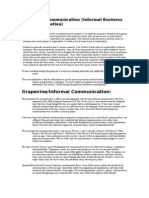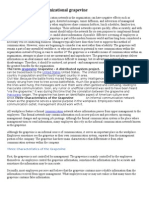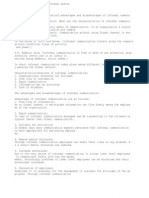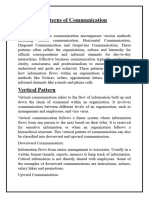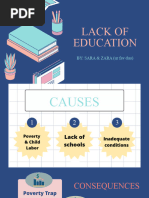0 ratings0% found this document useful (0 votes)
2 viewsCOMMUNICATION SKILLS WORK
COMMUNICATION SKILLS WORK
Uploaded by
isaacCOM
Copyright:
© All Rights Reserved
Available Formats
Download as DOCX, PDF, TXT or read online from Scribd
COMMUNICATION SKILLS WORK
COMMUNICATION SKILLS WORK
Uploaded by
isaac0 ratings0% found this document useful (0 votes)
2 views5 pagesCOM
Copyright
© © All Rights Reserved
Available Formats
DOCX, PDF, TXT or read online from Scribd
Share this document
Did you find this document useful?
Is this content inappropriate?
COM
Copyright:
© All Rights Reserved
Available Formats
Download as DOCX, PDF, TXT or read online from Scribd
Download as docx, pdf, or txt
0 ratings0% found this document useful (0 votes)
2 views5 pagesCOMMUNICATION SKILLS WORK
COMMUNICATION SKILLS WORK
Uploaded by
isaacCOM
Copyright:
© All Rights Reserved
Available Formats
Download as DOCX, PDF, TXT or read online from Scribd
Download as docx, pdf, or txt
You are on page 1of 5
METROPOLITAN INTERNATIONAL UNIVERSITY
FACULTY OF BUSINESS AND MANAGEMENT SCIENCE
INDIVIDUAL COUREWORK ASSIGNMENT
COMMUNICATION SKILLS – YEAR ONE, SEMESTER ONE
NAME: MUSIBIRA DANIEL
REG. NO: 23/BBA/082/UMC
COURSE: BBA
PROGRAM: WEEKEND
Question
Grapevine is an informal mechanism where management has ears and eyes
amongst workers. As a communication expert, present a case FOR or
AGAINST this communication practice. Include research references and use
bookman old style font.
Answers
I will present a case AGAINST the grapevine communication practice. While
informal communication can sometimes be useful in certain situations, it
often poses significant challenges and drawbacks in the workplace. Here are
several reasons why grapevine communication should be discouraged:
1. Lack of Accuracy and Reliability:
Research by Riggio (2017) suggests that grapevine communication is often
riddled with inaccuracies and rumors. Information passed through the
grapevine tends to become distorted as it travels from person to person,
leading to misunderstandings and false assumptions. This lack of accuracy
can result in poor decision-making within an organization.
2. Potential for Misinterpretation:
According to a study published in the Journal of Communication Management
(Bundy & Pfarrer, 2015), grapevine communication is prone to
misinterpretation. Since it relies heavily on informal channels, messages can
be easily misinterpreted, leading to confusion and conflicts among
employees.
3. Negative Impact on Organizational Culture:
The grapevine can foster a culture of gossip and mistrust within an
organization. Research by Robbins and Judge (2019) highlights that
excessive reliance on informal communication channels can erode trust
among employees and undermine the overall organizational culture.
4. Lack of Accountability:
Unlike formal communication channels, the grapevine lacks accountability.
Information can be spread anonymously, making it challenging to identify
the source of false or damaging rumors. This lack of accountability can
create a toxic work environment.
5. Inefficiency:
A report by the Chartered Institute of Personnel and Development (CIPD,
2018) suggests that the grapevine can be highly inefficient. Employees may
spend excessive time discussing rumors and gossip instead of focusing on
their work tasks, which can hamper productivity.
6. Legal and Ethical Concerns:
The grapevine may be used to spread confidential or sensitive information,
potentially leading to legal and ethical issues for organizations. Unauthorized
disclosure of information can result in lawsuits and damage to an
organization's reputation.
7. Undermining Formal Channels:
Overreliance on the grapevine can undermine the effectiveness of formal
communication channels established by management. This can lead to a
breakdown in the chain of command and create confusion about which
information is official and which is not.
However, grapevine communication can also offer certain
advantages in specific situations.
Rapid Dissemination of Information:
The grapevine is often much faster than formal communication channels.
Research by Jones and George (2018) suggests that informal communication
spreads information swiftly through an organization. In emergency situations
or when time is of the essence, the grapevine can be a valuable tool for
quickly sharing critical updates.
Employee Engagement:
Grapevine communication can empower employees to voice their concerns,
opinions, and suggestions more freely. This sense of participation and
involvement can contribute to higher employee engagement, as suggested
by a report from Gallup (2019) on employee engagement in the workplace.
Identifying Issues and Concerns:
The grapevine can serve as a barometer of employee sentiments and
concerns. By listening to the grapevine, management can gain valuable
insights into employee morale, identify potential issues, and address them
proactively.
Supplementing Formal Communication:
Rather than replacing formal communication, the grapevine can complement
it. When used in conjunction with official channels, it can provide context and
interpretation to formal messages, helping employees better understand and
accept organizational changes.
Flexibility and Adaptability:
Informal communication channels, such as the grapevine, are often more
flexible and adaptable to changing circumstances. They can help employees
navigate uncertain situations and provide real-time feedback, enhancing an
organization's ability to respond to evolving challenges.
In conclusion, while informal communication can have some benefits in
fostering camaraderie among employees, the drawbacks of the grapevine
communication practice far outweigh the advantages. It often leads to
misinformation, misinterpretation, and a negative impact on organizational
culture and efficiency. Organizations should prioritize formal, transparent,
and accountable communication channels to ensure accurate and reliable
information flow within the workplace.
References:
1. Bundy, J., & Pfarrer, M. D. (2015). A burden of choice: Employee
consequences of adopting the grapevine as a sense making
instrument. Journal of Communication Management, 19(2), 162-182.
2. Chartered Institute of Personnel and Development (CIPD). (2018).
https://www.cipd.co.uk/knowledge/fundamentals/relations/gossip-
report
3. Robbins, S. P., & Judge, T. A. (2019). Organizational Behavior. Pearson.
4. Riggio, R. E. (2017). The social animal. Routledge.
5. Gallup. (2019). Employee Engagement in the U.S. Retrieved from
https://www.gallup.com/workplace/257349/employee-engagement-
drives-growth.aspx
6. Jones, G. R., & George, J. M. (2018). Essentials of Contemporary
Management. McGraw-Hill Education.
You might also like
- Analysis of Dead StarsDocument5 pagesAnalysis of Dead StarsJV Gamo62% (13)
- Kinder Where We Are in Place and Time Sy14-15Document7 pagesKinder Where We Are in Place and Time Sy14-15api-256382279100% (3)
- Com 520 - Communication GuideDocument13 pagesCom 520 - Communication Guideapi-279315678No ratings yet
- Lecture Notes Business Communication Unit IIDocument7 pagesLecture Notes Business Communication Unit IIAmit Kumar0% (1)
- Grapevine CommunicationDocument5 pagesGrapevine CommunicationSanthosh Kumar0% (1)
- Up, Down, and Sideways: High-Impact Verbal Communication for HR ProfessionalsFrom EverandUp, Down, and Sideways: High-Impact Verbal Communication for HR ProfessionalsRating: 5 out of 5 stars5/5 (1)
- Johns 10e Irm ch10Document22 pagesJohns 10e Irm ch10Jacob WeiseNo ratings yet
- Term Paper Business CommunicationDocument12 pagesTerm Paper Business CommunicationMirKhalidSaifullahNo ratings yet
- A Critical Comprehension Paper On BBDocument2 pagesA Critical Comprehension Paper On BBJamina JamalodingNo ratings yet
- Importance of GrapevineDocument5 pagesImportance of GrapevineManish Asnani67% (3)
- EJ1269874 SmallDocument3 pagesEJ1269874 SmallNigel BauleniNo ratings yet
- 67 ArticleText 136 1 10 20200708Document9 pages67 ArticleText 136 1 10 20200708suleimanNo ratings yet
- CSTUDY Jan22 CM POM6 Main Lucinda DinisDocument12 pagesCSTUDY Jan22 CM POM6 Main Lucinda DinisAndrea CortemigliaNo ratings yet
- Business CommunicationDocument9 pagesBusiness CommunicationShreyasi MishraNo ratings yet
- Peer Teaching SivaDocument6 pagesPeer Teaching Sivasivat05112002No ratings yet
- Communiction Assign.Document15 pagesCommuniction Assign.tisafar2000No ratings yet
- Organizational Communications Audits Asseessing Core Communications Competencies Within OrganizationsDocument13 pagesOrganizational Communications Audits Asseessing Core Communications Competencies Within OrganizationsroyNo ratings yet
- PROJECT MANAGEMENT - Written ReportDocument6 pagesPROJECT MANAGEMENT - Written ReportRyn DlwsNo ratings yet
- Grapevine CommunicationDocument17 pagesGrapevine CommunicationAngela Tobias Simara100% (3)
- E Section BC Group 7Document17 pagesE Section BC Group 7Shivangi RathiNo ratings yet
- Int. Buss Comm Ch. 4Document8 pagesInt. Buss Comm Ch. 4direahmeddireahmedNo ratings yet
- Learning Activity 4 - Business Case StudyDocument3 pagesLearning Activity 4 - Business Case StudyParth DasguptaNo ratings yet
- Organizational Communication-NetworksDocument5 pagesOrganizational Communication-Networksparabaditya142No ratings yet
- IJISET_V6_I8_14Document18 pagesIJISET_V6_I8_14lionmohan726No ratings yet
- Informal Communication in OrganizationsDocument3 pagesInformal Communication in OrganizationsAbdullah Ashik AdnanNo ratings yet
- The Informal Communication NetworkDocument9 pagesThe Informal Communication NetworkSujata KumariNo ratings yet
- Communication GapDocument15 pagesCommunication GapAshutosh ManeNo ratings yet
- Channels of Communication - Week9Document4 pagesChannels of Communication - Week9zakiposssssssNo ratings yet
- Organizational Communication-Part 1 PaperDocument4 pagesOrganizational Communication-Part 1 PaperHimanshu JaiswalNo ratings yet
- Business Managerial Communication ProjectDocument8 pagesBusiness Managerial Communication ProjectSaniyaNo ratings yet
- Written CommunicationDocument16 pagesWritten CommunicationRokon Uddin AhmedNo ratings yet
- Five Ways To Close The Employee Communications GapDocument4 pagesFive Ways To Close The Employee Communications GapHumphrey AgalaNo ratings yet
- Internal Communication Strategies and Employee EngagementDocument12 pagesInternal Communication Strategies and Employee EngagementEmmaNo ratings yet
- IndividualsEssay NguyenThiBichPhuong AEn7 21000524Document7 pagesIndividualsEssay NguyenThiBichPhuong AEn7 2100052421000999No ratings yet
- Communication SkillsDocument3 pagesCommunication Skillsteddybusingye2No ratings yet
- Module 2 - Channels of CommunicationDocument2 pagesModule 2 - Channels of CommunicationSREESAIARJUN KOSINEPALLINo ratings yet
- Grapevine CommunicationDocument4 pagesGrapevine CommunicationShofi TaneemNo ratings yet
- Business Communication and Etiquettes - GrapevineDocument5 pagesBusiness Communication and Etiquettes - Grapevineviralshukla85No ratings yet
- Busn Comm (Formal & Informal)Document4 pagesBusn Comm (Formal & Informal)Dhananjay SharmaNo ratings yet
- How To Foster Downward Communication at Mēness AptiekaDocument5 pagesHow To Foster Downward Communication at Mēness AptiekaMihaelaNo ratings yet
- Examining the Impact of Effective Communication on the Organisational Performance of the Public Relations Association of Uganda (PRAU) (www.kiu.ac.ug)Document5 pagesExamining the Impact of Effective Communication on the Organisational Performance of the Public Relations Association of Uganda (PRAU) (www.kiu.ac.ug)publication1No ratings yet
- 5007-2..... Roll No 3Document18 pages5007-2..... Roll No 3Noaman AkbarNo ratings yet
- Ask: How Is Our Day To Day Personal Communication Different With Business Communication?Document8 pagesAsk: How Is Our Day To Day Personal Communication Different With Business Communication?siriusNo ratings yet
- FLY HI - Content2Document17 pagesFLY HI - Content2ranjxyzNo ratings yet
- Managingcommunication AssignmentDocument14 pagesManagingcommunication AssignmentKhadeja RemizNo ratings yet
- Organizational CommunicationDocument6 pagesOrganizational CommunicationNeha JacksonNo ratings yet
- Effective Communication For Better ObDocument11 pagesEffective Communication For Better ObLorena Carrillo CerrilloNo ratings yet
- BC Assignment No 1Document5 pagesBC Assignment No 1Rehman KhanNo ratings yet
- Research Draft With Comment For Mehodology, Findings, Discusion and Recommendation.Document33 pagesResearch Draft With Comment For Mehodology, Findings, Discusion and Recommendation.Sehrish SherryNo ratings yet
- Barriers To Effective CommunicationDocument4 pagesBarriers To Effective CommunicationSANTIAGO Rhonalyn G.No ratings yet
- Informal CommunicationDocument2 pagesInformal Communicationsinghalmayanka1No ratings yet
- Thesis On Organizational Communication PDFDocument5 pagesThesis On Organizational Communication PDFchcothxff100% (1)
- Com10007 ProfolioDocument7 pagesCom10007 ProfolioTrọng Khôi ĐỗNo ratings yet
- Advantages and DisadvantageDocument2 pagesAdvantages and Disadvantageইফতি ইসলামNo ratings yet
- Internal Communication DissertationDocument8 pagesInternal Communication DissertationBestCollegePaperWritingServiceSingapore100% (1)
- 386-392 NoteeeDocument7 pages386-392 NoteeeNigel BauleniNo ratings yet
- QuizDocument6 pagesQuizarmanmund27No ratings yet
- Communication AuditDocument4 pagesCommunication AuditNavpreet KaurNo ratings yet
- Barriers To Effective Organizational CommunicationDocument14 pagesBarriers To Effective Organizational CommunicationJulieAnnFajardoNo ratings yet
- 4IR 1 Jan Jun2020 Week9Document7 pages4IR 1 Jan Jun2020 Week9BonginkosiNo ratings yet
- Communication in OrganisationsDocument17 pagesCommunication in OrganisationsEtiel MachingambiNo ratings yet
- Fai's Project-1-1Document60 pagesFai's Project-1-1kbr2pcftdtNo ratings yet
- 2Document5 pages2isaacNo ratings yet
- Christine NansubugaDocument1 pageChristine NansubugaisaacNo ratings yet
- Uganda Teachers' Education Consult (Utec) 2022 Making Guide Subsidiary IctDocument12 pagesUganda Teachers' Education Consult (Utec) 2022 Making Guide Subsidiary IctisaacNo ratings yet
- Group 3Document4 pagesGroup 3isaacNo ratings yet
- Transport A-LevelDocument52 pagesTransport A-LevelisaacNo ratings yet
- Mak CoBAMS Postgraduate Courses Admission List 2023 2024Document33 pagesMak CoBAMS Postgraduate Courses Admission List 2023 2024isaacNo ratings yet
- Mak MUBS Postgraduate Courses Admission List 2023 2024Document40 pagesMak MUBS Postgraduate Courses Admission List 2023 2024isaacNo ratings yet
- Mak CoCIS Postgraduate Courses Admission List 2023 2024Document18 pagesMak CoCIS Postgraduate Courses Admission List 2023 2024isaacNo ratings yet
- Killer Doll 1Document251 pagesKiller Doll 1Alchie Salinas100% (1)
- Osho: Insights For A New Way of LivingDocument2 pagesOsho: Insights For A New Way of LivingmascaNo ratings yet
- Orca Share Media1548384824029Document50 pagesOrca Share Media1548384824029KissSabayHug100% (4)
- Rahul HoraDocument2 pagesRahul HoraSheila Maye TortolaNo ratings yet
- People v. Dennis ManulitDocument1 pagePeople v. Dennis ManulitKarla BeeNo ratings yet
- Shariah Advisory Council (SAC)Document31 pagesShariah Advisory Council (SAC)Mahyuddin KhalidNo ratings yet
- Informant Policies & Practices Evaluation Committee ReportDocument47 pagesInformant Policies & Practices Evaluation Committee ReportLisa Bartley100% (1)
- This Study Resource WasDocument2 pagesThis Study Resource WasChezka QuinteNo ratings yet
- 3rd Year Literary StreamDocument3 pages3rd Year Literary StreamRima Coeur BlancNo ratings yet
- Thoughts On Job, From "Table Talk" by Martin LutherDocument3 pagesThoughts On Job, From "Table Talk" by Martin LutherKunedog1100% (1)
- Can You Feel The Love TonightDocument1 pageCan You Feel The Love Tonightbackupfamilia.correiarochaNo ratings yet
- Traditions in Political Theory Liberalism 1 PDFDocument21 pagesTraditions in Political Theory Liberalism 1 PDFmani tagejaNo ratings yet
- Ethics Case StudyDocument4 pagesEthics Case StudycasscactusNo ratings yet
- History SbaDocument18 pagesHistory SbaKristi Gopaul100% (1)
- The Flowering of The Hippie MovementDocument14 pagesThe Flowering of The Hippie MovementAnita Barboza SegoviaNo ratings yet
- 321 SyllabusDocument5 pages321 SyllabusCledwyn08No ratings yet
- Negotiable Instrument Law SyllabusDocument1 pageNegotiable Instrument Law SyllabusVel JuneNo ratings yet
- Makati Leasing vs. WeareverDocument1 pageMakati Leasing vs. WeareverJulie AnnNo ratings yet
- Zara&Sara GP UN PPDocument8 pagesZara&Sara GP UN PPsaralotia33No ratings yet
- Nothing Matters by CarlesDocument107 pagesNothing Matters by CarlesLiban Ali YusufNo ratings yet
- What Is The Main Point of The Essay "Shooting An Elephant" by George Orwell?Document17 pagesWhat Is The Main Point of The Essay "Shooting An Elephant" by George Orwell?thiagoomNo ratings yet
- Chap 006Document78 pagesChap 006Kiều Thảo Anh100% (1)
- Payod Vs Metila - A.C. No. 3944Document3 pagesPayod Vs Metila - A.C. No. 3944Karen HaleyNo ratings yet
- Moore (2022) Artificial Moral AdvisorsDocument10 pagesMoore (2022) Artificial Moral AdvisorsCésar Akim Erives ChaparroNo ratings yet
- Jacobean Revenge TragedyDocument5 pagesJacobean Revenge TragedynarkotiaNo ratings yet
- Difference Between Democracy and Dictatorship - Important IndiaDocument9 pagesDifference Between Democracy and Dictatorship - Important IndiaAna JainNo ratings yet
- (Reason For Writing) (Opinion)Document2 pages(Reason For Writing) (Opinion)Nikos PastrasNo ratings yet
- Jenkins 2012 Philosophy CompassDocument10 pagesJenkins 2012 Philosophy CompassmacNo ratings yet




